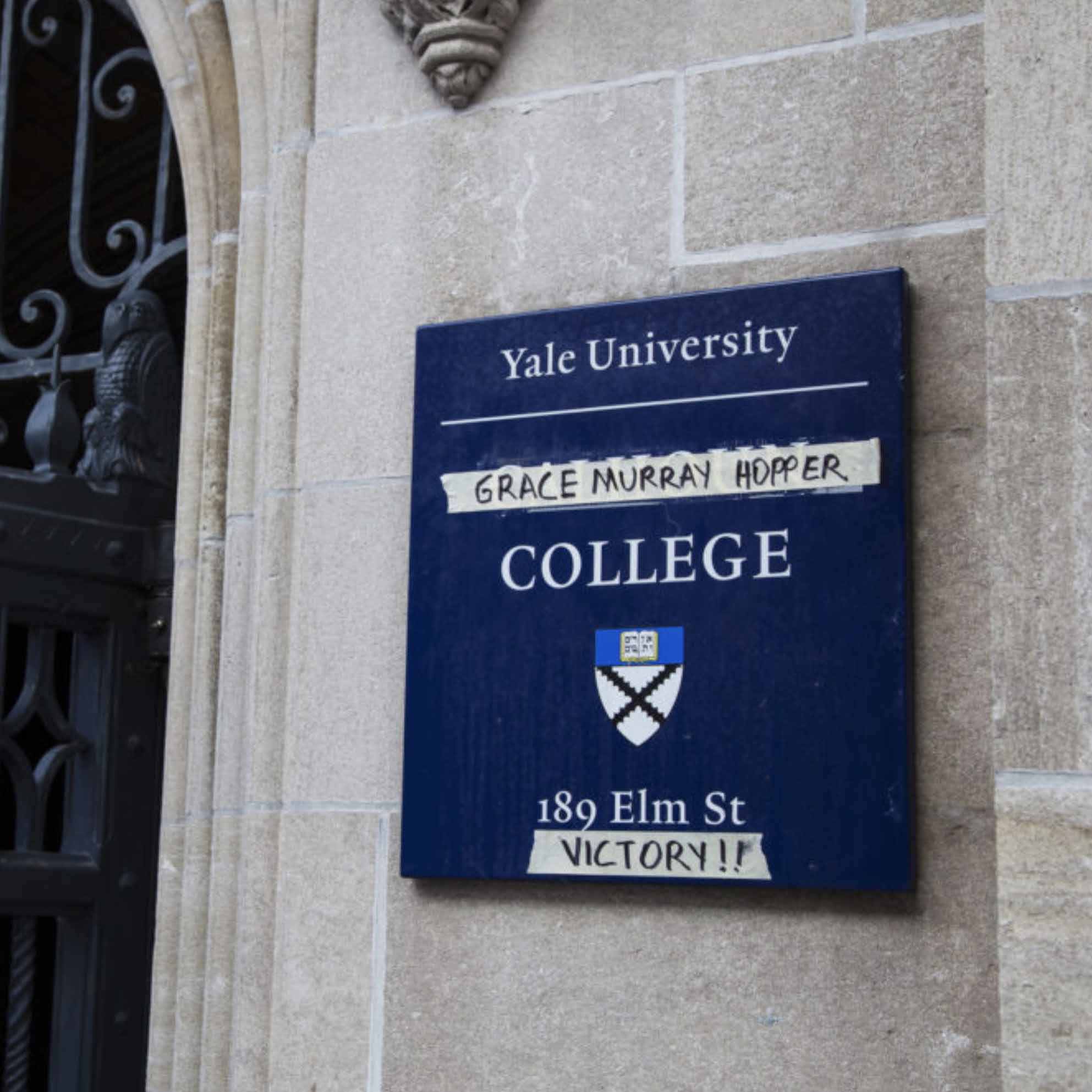
As first-year students in Grace Hopper College arrived at the Roosevelt Thompson dining hall for their inaugural banquet this fall, they were greeted by a smiling portrait of the hall’s namesake—a high-achieving black student who died just two months before his graduation. But just two years ago, the college’s first years ate in that same dining hall under stained glass windows depicting images of slavery and the antebellum South.
All representations of slavery in the dining hall have since been removed, along with scenes from the life of the college’s former namesake, John C. Calhoun, class of 1804, that once occupied the windows in the common room. Now, the Hopper College Window Commission Committee is searching for artists to create new windows for the college. On Thursday afternoon, the committee met for the second time to review 50 nominated artists.
“There’s two motivations for the project,” said committee chair Anoka Faruqee, a professor in the School of Art. “One is to celebrate the life of Grace Hopper and the other is to confront the college’s history, which is a motivation exemplified by the renaming and the removal of the windows.”
University President Peter Salovey chartered the committee last April, after the college’s renaming, to recommend proposals for window replacements. Its members include Yale administrators, faculty in the arts and American history, Hopper Head of College Julia Adams and four current Hopper students.
The committee has spent the past month collecting nominations for artists from professionals in the arts. In preparation for Thursday’s meeting, staff at the University president’s office prepared a compilation of biographies and portfolios for the 50 nominated artists.
“Among the nominations, a large portion of them are African-American artists … I think that may have to do with the motivation of confronting the college’s history and confronting the contexts and relationship to slavery,” Faruqee said. “Many of the artists nominated have dedicated their practice to examining those histories.”
Faruqee added that the committee plans to form separate commissions to find artists for the two spaces with available window paneling — the dining hall and the common room.
The artist, or artists, who create the new windows will have to integrate their work with the remaining stained-glass paneling, which depict flora and fauna of the American South.
“That’s a challenge for anyone working when you have to negotiate so many different narratives,” said John Gordon, an art curator and member of the committee. “I hope the person who does it has the kind of intellectual curiosity and dexterity to be able to take on the past and the present in really fascinating and holistic ways.”
The five self-contained blank windows in the common room could house a depiction of Grace Hopper, Faruqee said.
Controversial stained-glass paneling in the college has long been a subject of student protest. In 1992, the University replaced a panel depicting a shackled slave kneeling at Calhoun’s feet after students called for its removal. Nearly 25 years later, as students grappled with the University’s decision in April 2016 to keep the name Calhoun, Adams announced that images of Calhoun in the common room would be replaced with tinted glass.
According to Gordon, all but one of the removed windows are available for public viewing at Sterling Memorial Library.
The one unavailable panel, which depicted slaves picking cotton, was shattered in June 2016 by Yale dishwasher Corey Menafee in an act of protest. Menafee was briefly arrested and dismissed from his position at the University for the incident, but was later reinstated after local activists rallied to his cause.
Although a number of shards of the panel were lost or shattered, Yale University Art Gallery staff are currently in the process of restoring it. The window will join the others at Sterling after conservators at the YUAG affix pieces of the panel to a sheet of plastic.
In an interview with the News, Menafee said the new windowpanes represent an opportunity to reconcile the future with the University’s values.
“Those old images were representative of Calhoun … and the exploitation of others,” Menafee said. “The new images should represent a new era. They should also go in line with the school motto, which is truth and enlightenment.”
Menafee added that he hopes the new images are emblematic of learning and technology in the 21st century. For example, instead of an image of two slaves carrying barrels of cotton over their heads, panels could depict two students learning, he said.
For the Hopper College community, the windows are a physical hallmark of change and an opportunity to develop a new identity.
“I’m thrilled that the process to create new windows, in dialogue with the old, is rolling,” Adams said. “We’ll see a beautiful engagement with history — including the old windows — and the future in our dining hall and common room.”
Student activists say the changes to the college over the last year bear testament to the influence that students can have on the University. Seon De Souza Ferreira ’20 said the new windows represent a concrete effort to establish a new college rather than one under a different name.
Sam Leander ’19 said the new windows are a chance for Yale to signify its values, and added that choosing Grace Hopper as the college’s namesake was a signal in itself. Leander suggested the windows could display naval scenes and experiment with stained glass as a genre.
Several other students, including Khaleel Rajwani ’20, said the new windows should depict Grace Hopper herself. Rajwani added that panels designed by students could revitalize the project.
Francine Rios-Fetchko ’20 said the new windows are a small step toward changing the overall culture of the college. The renaming of the dining hall, Roosevelt Thompson’s new portrait and other changes around Hopper are establishing a new dynamic for first years, Rios-Fetchko said.
Grace Hopper earned her Ph.D. in mathematics from Yale in 1934.
Hailey Fuchs | hailey.fuchs@yale.edu







